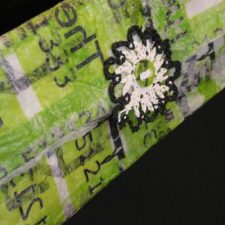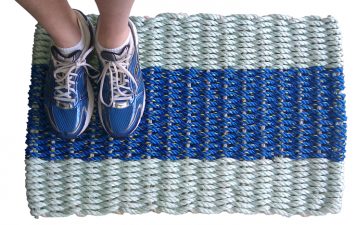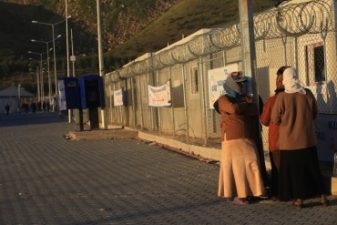 Syria’s war has killed 150,000 people and forced more than three million from their homes. About a million of these refugees live in Jordan and as many as 200,000 have lived in the Zaatari refugee camp near Jordan’s Syrian border. This Green Prophet visited nearby Zaatari village where another 500 refugees live. One of the Syrian refugees who live here is a little girl with a broken shoe. This girl and dozens of other children of Zaatari village learned a little bit about recycling on one of the many cloudless spring days in the desert.
Syria’s war has killed 150,000 people and forced more than three million from their homes. About a million of these refugees live in Jordan and as many as 200,000 have lived in the Zaatari refugee camp near Jordan’s Syrian border. This Green Prophet visited nearby Zaatari village where another 500 refugees live. One of the Syrian refugees who live here is a little girl with a broken shoe. This girl and dozens of other children of Zaatari village learned a little bit about recycling on one of the many cloudless spring days in the desert.
My family and I wanted to learn about the needs of Syrian refugees. So before our recent trip to Jordan, we asked Green Prophet’s Laurie Balbo about volunteer organizations there.
Laurie was a crucial boots-on-the-ground volunteer who performed a bureaucracy-defying miracle to get thousands of donated Irish knit hats to children at Zaatari before winter’s end and long before larger relief agencies were able to complete their winter clothing distribution.
Laurie works with Studio Syria and other organizations inside the Zaatari refugee camp. She was also familiar with a French NGO named Dar Al Yasmin (DAY), which means “House of Yasmin.” It was named after Syria’s fragrant national flower. DAY was formed in 2013 to focus on the needs of families living in Zaatari village.
DAY cofounder Gaelle Sundelin has the crucial mix of organization and language skills, leadership, creativity, optimism, patience, peacemaking and enough pragmatism to recognize that she can’t do it all herself. So for this typical Habaybi (caring love) event Gaelle recruited about 50 people from France, Ireland, Italy, Jordan, Sudan and Somalia. The young men from these last two countries told me that wars had forced them to leave their homelands and that they hoped to return one day.
[youtube]https://www.youtube.com/watch?v=-c5-_wzPUqw[/youtube]
We met Gaelle and other DAY volunteers at a bus stop in Amman Jordan on Good Friday. We would fill two minibuses with a diverse group of teachers, artists, musicians, an acroclown circus and my family of four.
Some circus performers tuned their instruments while another handed out plastic clown noses. The troupe burst into song to lighten the mood at security checkpoints and shorten the journey to Zaatari. Our ten-year-old daughter called it the most fun bus ride she has ever been on.
While other volunteers worked on a variety of craft and entertainment projects, my family was asked to help make kites. Gaelle explained that we would make the kites out of plastic bags and cardboard so that the children would learn about recycling. During the long bus ride north, Gaelle wondered aloud whether we would have enough materials for the kites. I looked across dusty fields littered with plastic bags and wondered how we could ever run out.
 [youtube]https://www.youtube.com/watch?v=I6eQxkmMWSs#t=154[/youtube]
[youtube]https://www.youtube.com/watch?v=I6eQxkmMWSs#t=154[/youtube]
Volunteers Muhammad Husseis and Feras Hamwy had built a flying prototype kite made from a plastic bag and decorated with Barcelona football club stickers. This was two days after Real Madrid took home the Spanish cup but the Barcelona stickers were a huge hit with the kids as were the Cars, Angry Birds, Spiderman and smiley face stickers. I only knew how to say “Hello” and “Thank you” in Arabic, but “Barcelona” was a universal happy word that day.
This was the first valuable lesson for us, these kids aren’t so different from our own children or from others we’ve known in Ireland, the US and elsewhere.
We used a hot glue gun to assemble the traditional “kite-shaped” kites. It must be natural to feel somewhat useless when trying to help others overcome seemingly intractable problems. But I soon found my purpose as goalie trying to keep the children from burning themselves on the hot glue guns. I began to wish we had used duct tape! But then I noticed that these kids were different. Their level of chaotic energy was high but nothing beyond what I’d seen in the Irish Sunday school classes. The difference being that this room full of 30 kids seemed at even more manageable than my Sunday school class of 8.
When the kites were finished, the children took them outside and we began to clean up. But the kites were so popular that the word soon spread and had a new influx of children eager to turn every scrap of plastic and cardboard they could find into a kite. At first we shrugged our shoulders and thought why not?
But when the chaos rose and we decided to pull the plug on the hot glue guns. As they cooled off, a 5 year-old boy presented his half-finished kite, flicked out a cigarette lighter and offered to reheat the glue for me. I told him, “La shukran.”
That was when someone carried in the little girl. She wore a white and pink floral dress and a beaded bracelet she had made with another arts and crafts group. She handed me the broken shoe. A plastic jewel had fallen off of its buckle.
There was just enough heat left in the glue gun to stick it back on. These children did learn something about recycling on that day. And I learned that even the smallest act of kindness is never wasted.
Photos provided by Dar Al Yasmin (DAY.)




3 thoughts on “Syrian refugee children upcycle Jordan’s litter into kites”
Comments are closed.